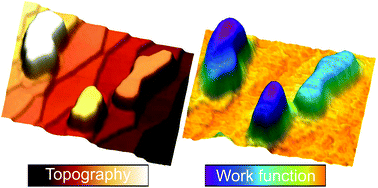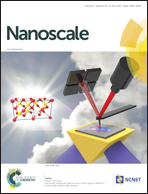Near-equilibrium measurement of quantum size effects using Kelvin probe force microscopy†
Abstract
In nano-structures such as thin films electron confinement results in the quantization of energy levels in the direction perpendicular to the film. The discretization of the energy levels leads to the oscillatory dependence of many properties on the film thickness due to quantum size effects. Pb on Si(111) is a specially interesting system because a particular relationship between the Pb atomic layer thickness and its Fermi wavelength leads to a periodicity of the oscillation of two atomic layers. Here, we demonstrate how the combination of scanning force microscopy (SFM) and Kelvin probe force microscopy (KPFM) provides a reliable method to monitor the quantum oscillations in the work function of Pb ultra-thin film nano-structures on Si(111). Unlike other techniques, with SFM/KPFM we directly address single Pb islands, determine their height while suppressing the influence of electrostatic forces, and, in addition, simultaneously evaluate their local work function by measurements close to equilibrium, without current-dependent and non-equilibrium effects. Our results evidence even–odd oscillations in the work function as a function of the film thickness that decay linearly with the film thickness, proving that this method provides direct and precise information on the quantum states.



 Please wait while we load your content...
Please wait while we load your content...